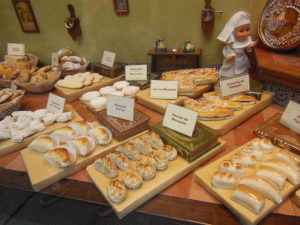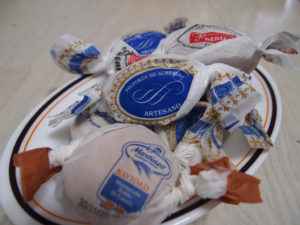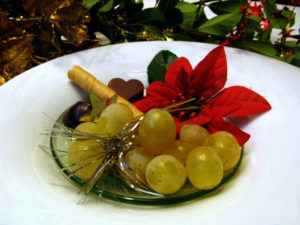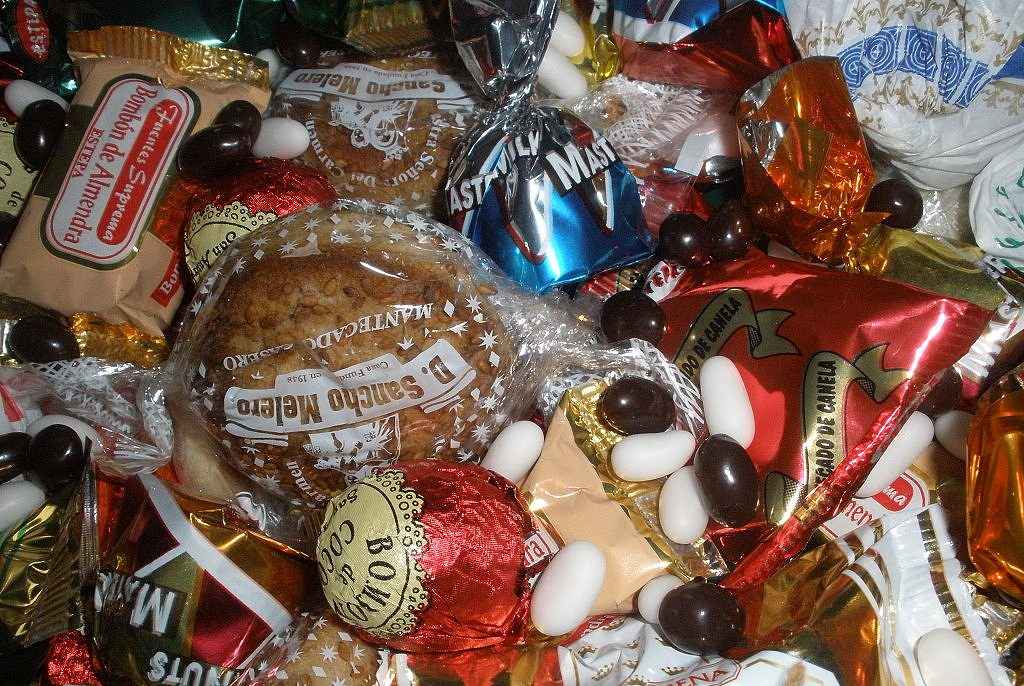Christmas would not be Christmas in Spain without traditional Christmas treats such as turrón (Spanish nougat), marzipan and polvorones (almond cookies). These sweet delicacies are as much a feature of Christmas in Spanish households as Christmas trees, nativity scenes and Christmas decorations.
Turrón
Turrón is a very old, traditional sweet of Moorish (Arabic) origin. Turrón has been a popular sweet for centuries, even outside Spain’s borders. It is said that the Moors invented turrón over 500 year ago in Jijona, a small town about 30 miles or so north of Alicante. Jijona’s economy is focused on the production of turrón and there is even a museum of turrón that chronicles the process and history of the sweet.
Far and away the most common treat you’ll find, turrón is a nougat bar made from sugar, egg whites and honey, and are most traditionally made with nuts. The most celebrated types are hard (Alicante sort) and soft (Jijona type), though you can find them made of chocolate, infused with liquor, containing candied fruit or puffed rice or even with candy brands inside.

Alicante turrón(hard nougat) is created through the boiling of a honey, sugar and egg white mass, to which almonds, peeled and toasted, are added and mixed. The turrón is then air dried before being cut and shaped into rectangular boxes and bars for packaging.
Jijona turrón(soft nougat) follows the same procedure but goes through a grinding mill for additional refining before being transferred to vats for reheating. At this point the Turronero (the craftsmen who produce the turrón) play a key role by mixing the softened nougat with traditional paddles. It is the Turronero who determine the optimum point of the nougat production process and ensure that no two Jijona turróns are everalike.
Mazapán (Marzipan)
A traditional shortbread in Castilla y León and Castilla-La Mancha, this almond paste-based confection is often shaped into bite-sized morsels and have sugar or egg yolk filling.

Although Venice and the Orient argue with Toledo’s claims to having invented marzipan or mazapan, it is generally thought that the Moors brought a sweet almond and honey mixture to the Iberian peninsula when they invaded in the 8th century. They are believed to have called it mautha-ban or mahsaban. There are still other stories from Venice and even one about the nuns of San Clemente feeding the soldiers who were wounded in Navas de Tolosa battle in 1212 A.D. a type of almond bread. Wherever it came from, it is absolutely delicious!
Today the gourmet varieties of marzipan still contain only sugar and almonds, although cheaper varieties contain rice flour and potato starch. Mazapan can come in the shape of little figures, covered with sugars or pine nuts or can even contain a rich, delicious filling.
As with Turrón, perfecting the marzipan making process comes with both experience and knowledge, particularly in terms of determining the end product. For example, factors such as the quality and quantity of almonds used will determine the level of moisture and consistency to be found in the final product.
Mantecados and Polvorones
Traditional Polvorones or Almond cookies are a rich, shortbread-type cookie. They are very traditional sweets whose recipes have not changed in centuries, with the exception of the use of the modern mixer. These cookies are very flakey and soft and are made with flour, lard or vegetable shortening, powdered sugar and cinnamon. The dough is refrigerated, then rolled out, cut and baked.

They are varieties of cake that originated in Estepa (Sevilla). Made of pig lard and olive oil, mantecados are quite popular in Andalucía and mass-produced here. These crumbly cookies come in a dozen varieties, like cinnamon, lemon, chocolate and anisette.
Polvorones are often sold in paper wraps and, due to its powdery consistency, those in the know recommend that it’s best squeezed in the hand before eating so as to compress the dough and avoid any mishaps!
Kings Cake (Roscón de Reyes)
January 6 – Dia de Los Reyes in Spanish – is virtually as important as Christmas itself in Spain, especially for kids, as this is the day when they get their presents! The fun starts the evening before, when the three kings lead their procession through the streets, the famous Cabalgata de Reyes, throwing sweets to the children. It’s kind of like the Santa Claus parade in Norh America.
A popular tradition is to eat a Roscón, a sweet, donut-shaped bread (though much bigger than a donut) covered in glacier cherries and sugar. A plastic toy is buried inside the mixture, so don’t dive in too quickly. He or she who finds the toy gets good luck for the next year (double the luck if they also ate the grapes on New Year’s Eve!).

Las 12 Uvas de Nochevieja
Grapes are not really a sweet, but one of the greatest traditions at Christmas in Spain. Eating 12 grapes at midnight on New Year’s Eve is both a tradition and a superstition. Rare is the Spaniard who will risk poisoning their fate for the coming year by skipping the grapes, one for each stroke of midnight.

Eating the grapes pretty much guarantees starting off the year with a little adrenaline rush, and most likely some laughs. The Twelve Grapes (Las doce uvas de la suerte) dates back from at least 1895 but became established in 1909. In December of that year, some alicantese vine growers popularized this custom to better sell huge amounts of grapes from an excellent harvest.
The tradition consists in eating a grape with each bell strike at midnight of December 31. According to the tradition, that leads to a year of prosperity. In some areas, it is believed that the tradition wards away witches and general evil.
The twelve grapes are linked to the Puerta del Sol tower clock, where this tradition started and from where the change of year is always broadcasted.

Additional information:
- Turrón – Spanish Almond Candy
- New Year’s Eve
- Twelve Grapes
- 12 Grapes At Midnight
- A Field Guide to Spanish Christmas Treats
Sigue disfrutando de Dream Alcalá:
- Telegram: Recibe nuestras noticias y contenido exclusivo (clic aquí).
- Newsletter: Recibe cada tarde un correo con nuestras últimas noticias (clic aquí).
- YouTube: Suscríbete para ver nuestros mejores vídeos (clic aquí).
 Sé tú el periodista: envíanos tus fotos o noticias a través de Telegram.
Sé tú el periodista: envíanos tus fotos o noticias a través de Telegram.

